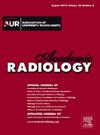Predicting Lymphovascular Invasion in Non-small Cell Lung Cancer Using Deep Convolutional Neural Networks on Preoperative Chest CT
IF 3.8
2区 医学
Q1 RADIOLOGY, NUCLEAR MEDICINE & MEDICAL IMAGING
引用次数: 0
Abstract
Rationale and Objectives
Lymphovascular invasion (LVI) plays a significant role in precise treatments of non-small cell lung cancer (NSCLC). This study aims to build a non-invasive LVI prediction diagnosis model by combining preoperative CT images with deep learning technology.
Materials and Methods
This retrospective observational study included a series of consecutive patients who underwent surgical resection for non-small cell lung cancer (NSCLC) and received pathologically confirmed diagnoses. The cohort was randomly divided into a training group comprising 70 % of the patients and a validation group comprising the remaining 30 %. Four distinct deep convolutional neural network (DCNN) prediction models were developed, incorporating different combination of two-dimensional (2D) and three-dimensional (3D) CT imaging features as well as clinical-radiological data. The predictive capabilities of the models were evaluated by receiver operating characteristic curves (AUC) values and confusion matrices. The Delong test was utilized to compare the predictive performance among the different models.
Results
A total of 3034 patients with NSCLC were recruited in this study including 106 LVI+ patients. In the validation cohort, the Dual-head Res2Net_3D23F model achieved the highest AUC of 0.869, closely followed by the models of Dual-head Res2Net_3D3F (AUC, 0.868), Dual-head Res2Net_3D (AUC, 0.867), and EfficientNet-B0_2D (AUC, 0.857). There was no significant difference observed in the performance of the EfficientNet-B0_2D model when compared to the Dual-head Res2Net_3D3F and Dual-head Res2Net_3D23F.
Conclusion
Findings of this study suggest that utilizing deep convolutional neural network is a feasible approach for predicting pathological LVI in patients with NSCLC.
利用术前胸部 CT 的深度卷积神经网络预测非小细胞肺癌的淋巴管侵犯。
理由和目标:淋巴管侵犯(LVI)在非小细胞肺癌(NSCLC)的精准治疗中发挥着重要作用。本研究旨在通过将术前 CT 图像与深度学习技术相结合,建立无创 LVI 预测诊断模型:这项回顾性观察研究纳入了一系列因非小细胞肺癌(NSCLC)接受手术切除并获得病理确诊的连续患者。研究人员将患者随机分为训练组和验证组,训练组由 70% 的患者组成,验证组由其余 30% 的患者组成。结合二维(2D)和三维(3D)CT 成像特征以及临床放射学数据的不同组合,开发了四种不同的深度卷积神经网络(DCNN)预测模型。模型的预测能力通过接收者操作特征曲线(AUC)值和混淆矩阵进行评估。德隆检验用于比较不同模型的预测性能:本研究共招募了 3034 名 NSCLC 患者,其中包括 106 名 LVI+ 患者。在验证队列中,双头 Res2Net_3D23F 模型的 AUC 最高,为 0.869,紧随其后的是双头 Res2Net_3D3F(AUC,0.868)、双头 Res2Net_3D(AUC,0.867)和 EfficientNet-B0_2D(AUC,0.857)。与双头 Res2Net_3D3F 和双头 Res2Net_3D23F 相比,EfficientNet-B0_2D 模型的性能没有明显差异:本研究结果表明,利用深度卷积神经网络预测 NSCLC 患者的病理 LVI 是一种可行的方法。
本文章由计算机程序翻译,如有差异,请以英文原文为准。
求助全文
约1分钟内获得全文
求助全文
来源期刊

Academic Radiology
医学-核医学
CiteScore
7.60
自引率
10.40%
发文量
432
审稿时长
18 days
期刊介绍:
Academic Radiology publishes original reports of clinical and laboratory investigations in diagnostic imaging, the diagnostic use of radioactive isotopes, computed tomography, positron emission tomography, magnetic resonance imaging, ultrasound, digital subtraction angiography, image-guided interventions and related techniques. It also includes brief technical reports describing original observations, techniques, and instrumental developments; state-of-the-art reports on clinical issues, new technology and other topics of current medical importance; meta-analyses; scientific studies and opinions on radiologic education; and letters to the Editor.
 求助内容:
求助内容: 应助结果提醒方式:
应助结果提醒方式:


